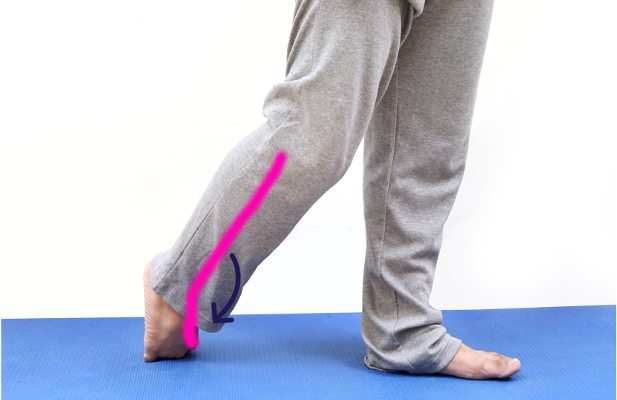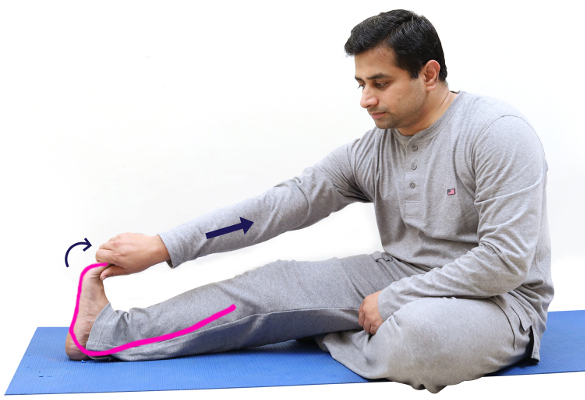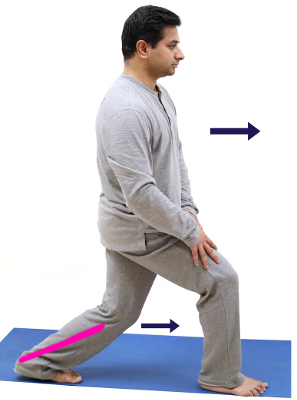

Steps for doing:
- The coloured part is being stretched.
- Stabilize the left leg.
- Bend right foot behind & towards left as shown.
- All Toes except big toe are bend as shown.
- Hold the same position for 10-20 seconds without holding your breath
In this video we are going to stretch Extensor digitorum longus muscle
The coloured part is being stretched as shown
The arrow indicates the direction of stretch
- Muscle responsible for dorsal foot and toe pain
- Symptoms refer to knee , leg , foot, ankle and 2nd 3rd 4th 5th toe region.
- Symptoms may include pain, numbness, hypersensitivity, altered sensation, irritability and also symptoms related to compression of adjacent blood vessels and nerves
- Commonly related to disease such as L4-L5 radiculopathy, deep peroneal nerve entapment, hammer toes,claw toes and others.

Steps for doing:
- The coloured part is being stretched.
- Stabilize the left leg.
- Bend right big toe behind & posteriorly as shown
- Hold the same position for 10-20 seconds without holding your breath.
In this video we are going to stretch Extensor hallucis longus muscle
The coloured part is being stretched as shown
The arrow indicates the direction of stretch
- Muscle responsible for foot drop, night cramps and growing pains.
- Symptoms refer to knee, ankle, foot and big toe region.
- Symptoms may include pain, numbness, hypersensitivity, altered sensation, irritability and also symptoms related to compression of adjacent blood vessels and nerves.
- Commonly related to disease such as deep peroneal nerve entrapment, L4-L5 radiculopathy, tendinitis, osteoarthritis of big toe and others.

Steps for doing:
- The coloured part is being stretched.
- Right lower limb in straight line..
- Hold the towel behind the sole of the foot as shown.
- Pull the left end of the towel.
- Right foot is rotated towards leftside as shown.
- Hold the same position for 10-20 seconds without holding your breath
In this video we are going to stretch Fibularis longus/ brevis muscle
The coloured part is being stretched as shown
The arrow indicates the direction of stretch
- Muscle responsible for weak ankle
- Affects especially those sitting with one leg crossed over other, mortons foot
- Symptoms refer to leg, ankle , heel and foot region.
- Symptoms may include pain, numbness, hypersensitivity, altered sensation, irritability and also symptoms related to compression of adjacent blood vessels and nerves
- Commonly related to disease such as entrapment of common,superficial, deep peroneal nerve, lateral compartment syndrome, lumbar disc syndromes and others.

Steps for doing:
- The coloured part is being stretched.
- Right lower limb in straight line.
- Hold the right foot toes 2,3, and 4.
- Pull them backwards as shown.
- Hold the same position for 10-20 seconds without holding your breath
In this video we are going to stretch Flexor digitorum longus muscle
The coloured part is being stretched as shown
The arrow indicates the direction of stretch
- Muscle responsible for calf,achilles,heel ,foot and toes pain
- Affects Runners ,joggers,and those walking in uneven surface
- Symptoms refer to plantar surface of foot, 2nd 3rd 4th toes
- Symptoms may include pain, numbness, hypersensitivity, altered sensation, irritability and also symptoms related to compression of adjacent blood vessels and nerves
- Commonly related to disease such as , flat foot, high arch foot, hammer toes, claw toes, and others.

Steps for doing:
- The coloured part is being stretched.
- Right lower limb in straight line.
- Hold the right foot big toe.
- Pull backwards as shown.
- Hold the same position for 10-20 seconds without holding your breath
In this video we are going to stretch Flexor hallucis longus muscle
The coloured part is being stretched as shown
The arrow indicates the direction of stretch
- Muscle responsible for calf,achilles,heel and foot pain
- Affects Runners ,joggers,and those walking in uneven surface
- Symptoms refer to plantar surface of foot, ball of the foot and big toe
- Symptoms may include pain, numbness, hypersensitivity altered sensation, irritability and symptoms related to compression of adjacent blood vessels and nerves
- Commonly related to disease such as tarsal tunnel syndrome, flat foot, high arch foot, hammer toes, claw toes,hallux valgus and others.

Steps for doing:
- The coloured part is being stretched.
- Stand against wall as shown.
- Right lower limb in straight line, and bend at ankle
- Move upper body(above hip) forward as shown, by bending left knee
- Hold the same position for 10-20 seconds without holding your breath
In this video we are going to stretch Gastrocnemius muscle
The coloured part is being stretched as shown
The arrow indicates the direction of stretch
- Muscle responsible for leg cramps, intermittent claudication
- Symptoms refer to knee, calf, ankle and foot region.
- Symptoms may include pain, numbness, hypersensitivity altered sensation, irritability and symptoms related to compression of adjacent blood vessels and nerves
- Commonly related to disease such as S1 radiculopathy, posterior compartment syndrome Achilles tendinitis, retrocalcaneal bursitis, failed back syndrome and others.

Steps for doing:
- The coloured part is being stretched.
- Stand against wall as shown.
- Right lower limb bend at right knee region and also bend at the right ankle region.
- Move forward as shown by bending left knee.
- Hold the same position for 10-20 seconds without holding your breath
In this video we are going to stretch Soleus muscle
The coloured part is being stretched as shown
The arrow indicates the direction of stretch
- Muscle responsible for growing pains, knee and ankle stability
- Symptoms refer to heel, knee, calf, ankle and foot region.
- Symptoms may include pain, numbness, hypersensitivity, altered sensation, irritability and also symptoms related to compression of adjacent blood vessels and nerves
- Commonly related to disease such as tibial nerve entrapment, S1 radiculopathy, Achilles tendinitis, plantar fasciitis, heel spur and others.

Steps for doing:
- The coloured part is being stretched.
- Keep left foot below right knee or a towel behind right knee
- Hold the sole of foot with the towel as shown.
- Pull the right hand end of the towel.
- Rotate the right foot towards right side.
- Hold the same position for 10-20 seconds without holding your breath
In this video we are going to stretch Tibialis posterior muscle
The coloured part is being stretched as shown
The arrow indicates the direction of stretch
- Muscle responsible for calf, achilles, heel and foot pain
- Affects Runners, joggers, and those walking in uneven surface
- Symptoms refer to plantar surface of foot, ball of the foot and big toe
- Symptoms may include pain, numbness, hypersensitivity, altered sensation, irritability and also symptoms related to compression of adjacent blood vessels and nerves
- Commonly related to disease such as flat foot, ankle deformity, tibialis posterior syndrome, tendinosis, tenosynovitis and others.

Steps for doing:
- The coloured part is being stretched.
- Stand as shown with support.
- Bend forward with sole of the feet facing behind.
- Toes and feet bent against floor as shown.
- Hold the same position for 10-20 seconds without holding your breath
In this video we are going to stretch Tibialis anterior muscle
The coloured part is being stretched as shown
The arrow indicates the direction of stretch
- Muscle responsible for standing balance ,foot weakness, ankle weakness
- Symptoms refer to knee, leg, foot, ankle and big toe region.
- Symptoms may include pain, numbness, hypersensitivity, altered sensation, irritability and also symptoms related to compression of adjacent blood vessels and nerves
- Commonly related to disease such as radiculopathy, anterior compartment syndrome foot drop, and others.

Steps for doing:
- The coloured part is being stretched.
- Sit in a couch, in the corner
- Hold the right knee as shown with both hands.
- Rotate right ankle region outwards, till you feel stretch in popliteal region
- Hold the same position for 10-20 seconds without holding your breath
In this video we are going to stretch Popliteus muscle
The coloured part is being stretched as shown
The arrow indicates the direction of stretch
- Muscle responsible for unlocking knee
- Affects especially going downhill/downstairs, and crouching
- Symptoms refer to knee joint, leg and thigh regions.
- Symptoms may include pain, numbness, hypersensitivity, altered sensation, irritability and also symptoms related to compression of adjacent blood vessels and nerves
- Commonly related to disease such as popliteus tendinitis, instability of knee joint, and others.
 Brain and Spine Secrets
Brain and Spine Secrets